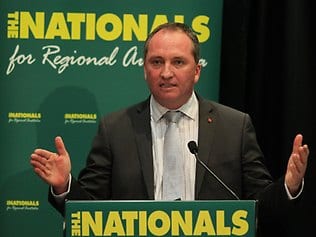There’s right, and there’s wrong… and then there’s Barnaby Joyce.
Joyce – Australia’s LNP minister for agriculture who was recently sworn in as deputy leader of the entire country – was right when he declared the cost of electricity bills to be one of the uppermost issues for Australian consumers, in an interview with the Adelaide Advertiser on Thursday.

He was wrong, however, when he suggested that the answer to the issue of electricity prices was not renewable energy, but nuclear, what he described as the “the ultimate renewable energy”.
Joyce, as we learned in our piece last year, “Barnaby Joyce’s renewable energy target: 100% ignorance” is one of the biggest opponents of wind farms in the Coalition, and it’s a little ironic to see that his electorate is about to became a major renewable energy hub, with two large wind farms and solar farms to be built near Glen Innes.
So it’s not necessarily surprising that he took another pot shot at renewables in the Murdoch media today. Here’s some of what he told the Advertiser:
“People want to make sure that we have a more efficient and clean energy sector but when it comes to paying the bills one thing that is No. 1 on their issues … is the price of power…
“The biggest fact you’ve got to think about is people’s capacity to pay for things. If people can’t afford to pay for it, they don’t want to be part of it … You don’t want to be so far in front (on renewable energy) that you scare all the people that you represent. If you’re an experiment, then you’re either going to be heroic or dead.”
Commenting on SA’s world-leading sourcing of electricity from wind and solar, Mr Joyce said the state needed affordable, reliable power not affected by “the vagaries of the day” — whether the sun shines or wind blows.
Back in 2013, he made his feelings clear, when he lamented to the Senate the “insane lemming-like desire to go to renewables” in Australia, and questioned what it would do to the national economy.
What is a little surprising is his endorsement of nuclear as a suitable and cheap alternative for new electricity generation in South Australia, as old coal-fired power is retired, when this is precisely the opposite finding arrived at by various recent and significant studies on the subject, not least of all the SA Royal Commission into nuclear power for Australia.
To be fair to Joyce, the Commission’s findings were a little confusing, in that they ruled out nuclear power as a viable alternative for Australia, but urged authorities to consider it anyway. But on the subject of nuclear generation for South Australia, the conclusion was clear: it wasn’t viable in the state for the foreseeable future (2030), even with a significant carbon price and a sharp reduction in the cost of capital.
Another major report from November 2015 – this time based on research undertaken by the Electric Power Research Institute (EPRI), Worley Parsons in Australia and Ernst and Young, and peer reviewed by the Australian Government Bureau of Resource Research Economics (BREE) – came to a similar conclusion.
The 362-page Australian Power Generation Technology Report essentially ruled out nuclear power for the whole of Australia, revealing that the technology was becoming more and more prohibitively expensive, at around double the capital cost estimated three years ago – and double the cost of competing technologies.
The collaborative research effort from more than 40 organisations, including the CSIRO, ARENA, the federal government’s Department of Industry and Science and the Office of the Chief Economist clearly showed, in fact, that solar and wind would be the cheapest low carbon technologies in Australia.
As you can see in the tables below, based on the levelised cost of energy (LCOE) – which is the the average cost of producing electricity from that technology over its entire life – nuclear is found to be more expensive than wind and five out of six solar technologies in 2015.

By 2030 (below), it is more expensive than everything. And this is the figure that counts, as we noted back then, because it is an impossibility that nuclear could be built in Australia before that time. Some would suggest it would take another 10 years.








